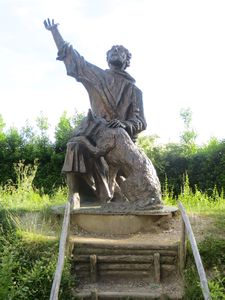Advertisement

 St Francis of Assisi and the wolf
St Francis of Assisi and the wolf
St Francis tames the wolf of Gubbio Gail has been going to school the last three days, and has found herself in an Italian language class of people who are mainly opera singers polishing their Italian pronunciation. It is absolutely sublime walking around the narrow cobblestone streets near the school filled with their powerful operatic voices.
Yesterday, as part of the “cultural exchange” curriculum, an outing to the town of Gubbio was arranged. Steve went along too. The bus trip took just on an hour each way through beautiful country side – steep mountains, rolling hills, narrow roads, Autostrada (freeways) and very old towns.
Gubbio is a medieval ancient town that dates back to pre-Roman times. That’s 2,500 years ago! There’s quite a bit of information at this web site:
http://en.wikipedia.org/wiki/Gubbio There are the ruins of an impressive Roman Theatre built in the 1
st Century. Unfortunately we didn’t have time to visit it.
It is said that St Francis of Assisi, in the 13
th Century, tamed the wolf of Gubbio (see the story here:
http://www.anaflora.com/articles/saints-sages/saint-1.html ). Assisi is only about 29 km from Gubbio (by road). There is a church dedicated to St
Francis here, and outside it, there’s a statue of St Francis with the wolf
We were very impressed with the town, it’s architecture and it’s ceramics.
We spent most of our time in the Palazzo dei Consoli, and wandering the streets.
This Palazzo was also a museum. Amongst many very interesting artefacts, are the 7 Iguvine Tablets. They are a series of seven bronze tablets discovered at Lguvium (contemporary Gubbio), Italy, in the year 1444. They are also known as Eugubian tablets. The earliest tablets were probably written in the 3rd century BC in the native Umbrian alphabet, the latest in the 1st century BC in the Latin alphabet. See here for more information is you should be interested -
http://en.wikipedia.org/wiki/Iguvine_Tables . Parts of the tablets have never been translated because they are written in ancient Etruscan, a language that has been lost over the centuries.
After 3 hours, our visit came to an end and we boarded the bus for the return journey – we would loved to have spent a lot more time there, as there was so much to see, and we only saw a short glimpse

 Gubbio Pottery
Gubbio Pottery
Gail with some of the potteryof it all.
On Sunday the school has arranged another day-long excursion, this time to Florence. Can’t wait to catch up with Michelangelo’s David, Botticeli’s………….and of course the fabulous shopping!
Advertisement
Tot: 0.076s; Tpl: 0.009s; cc: 10; qc: 52; dbt: 0.0336s; 1; m:domysql w:travelblog (10.17.0.13); sld: 1;
; mem: 1.1mb

 St Francis of Assisi and the wolf
St Francis of Assisi and the wolf
 Gubbio Pottery
Gubbio Pottery
